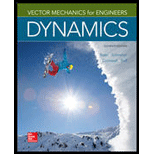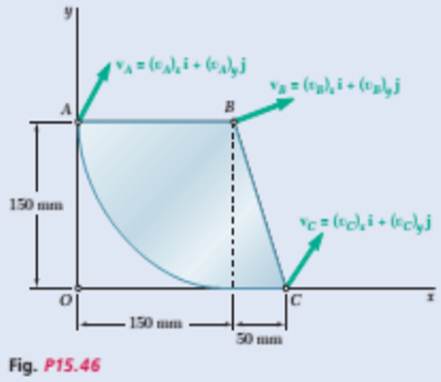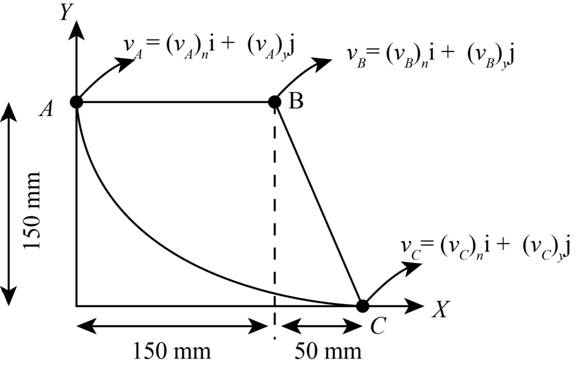
Concept explainers
The plate shown moves in the xy plane. Knowing that (vA)x=250 mm/s, (vB)y=−450 mm/s and (vc)x=−500 mm/s, determine (a) the angular velocity of the plate, (b) the velocity of point A.

(a)
The angular velocity of the plate.
Answer to Problem 15.46P
The angular velocity of the plate is −5 rad/s.
Explanation of Solution
Given Information:
The figure below shows a plate moving in x-y plane.

Figure-(1)
The velocity along x- direction of the point A is 250 mm/s, the velocity of point B along y -direction is −450 mm/s and the velocity of point C along x -direction is −500 mm/s.
Write the expression for position vector of AB.
rB/A=(Bx−Ax)i+(By−Ay)j ...... (I)
Here, the coordinates of point A is (Ax, Ay) and the coordinates of point B is (Bx, By).
Write the expression for the velocity at point A.
vA=(vA)xi+(vA)yj ...... (II)
Here, the velocity of point A along x -direction is (vA)x, the velocity of point A along y -direction is (vA)y.
Write the expression for the velocity at point B.
vB=(vB)xi+(vB)yj ...... (III)
Here, the velocity of point B along x -direction is (vB)x, the velocity of point B along y -direction is (vB)y.
Write the expression for the velocity at point C.
vC=(vC)xi+(vC)yj ...... (IV)
Here, the velocity of point C along x -direction is (vC)x, the velocity of point C along y -direction is (vC)y.
Write the expression to calculate the velocity of point B.
vB=vA+ωk(rB/A) ..... (V)
Here, the angular velocity of the plate is ω.
Write the expression for velocity at point C.
vC=(vA)x+ωk(rC/A) ...... (VI)
Write the expression for position vector of CA.
rC/A=(Cx−Ax)i+(Cy−Ay)j ...... (VII)
Here, the coordinates of point C is (Cx, Cy).
Calculation:
Substitute 0 mm for Ax, 150 mm for Ay, 150 mm for Bx and 150 mm for By in Equation (I).
rB/A=(150 mm−0 mm)i+(150 mm−150 mm)j=(150 mm)i
Substitute 0 mm for Ax, 150 mm for Ay, 200 mm for Cx and 0 mm for Cy in Equation (VII).
rC/A=(200 mm−0 mm)i+(0 mm−150 mm)j=(200 mm)i−(150 mm)j
Substitute (vC)xi+(vC)yj for (vC), (vA)xi+(vA)yj for vA and (200 mm)i−(150 mm)j for rC/A in Equation (VI).
(vC)xi+(vC)yj=(vA)xi+(vA)yj+ωk((200 mm)i−(150 mm)j) ...... (VIII)
Substitute −500 mm/s for (vC)x and 250 mm/s for (vA)x in Equation (VIII).
(−500 mm/s)i+(vC)yj=[(250 mm/s)i+(vA)yj+ωk((200 mm)i−(150 mm)j)](−500 mm/s)i+(vC)yj=[(250 mm/s)i+(vA)yj+((200ω mm)j−(150ω mm)i)] ...... (IX)
Equate the coefficients of i in Equation (IX).
(−500 mm/s)=(250 mm/s)+(150ω mm)ω=−750 mm/s150 mmω=−5 rad/s
Conclusion:
The angular velocity of the plate is −5 rad/s and the negative sign indicates the clockwise direction of the angular velocity.
(b)
The velocity of point A.
Answer to Problem 15.46P
The velocity of point A is 390.51 mm/s.
Explanation of Solution
Write the expression for velocity of point A.
vA=√(vA)2x+(vA)2y ...... (X)
Calculation:
Substitute (vB)xi+(vB)yj for vB
(vA)xi+(vA)yj for vA and (150 mm)i for rB/A in Equation (V).
(vB)xi+(vB)yj= [(vA)xi+(vA)yj+ωk(150 mm)i](vB)xi+(vB)yj= [(vA)xi+(vA)yj+ω(150 mm)j] ...... (XI)
Substitute −450 mm/s for (vB)y
250 mm/s for (vA)x and −5 rad/s for ω in Equation (XI).
(vB)xi+(−450 mm/s)j=[(250 mm/s)i+(vA)yj+(150(−5 rad/s) mm)j](vB)xi+(−450 mm/s)j=[(250 mm/s)i+(vA)yj+(−750 mm/s)j] ...... (XII)
Equate the coefficients of j in Equation (XII).
(−450 mm/s)=(vA)y−750 mm/s(vA)y=300 mm/s
Substitute 300 mm/s for (vA)y and 250 mm/s for (vA)x in Equation (X).
va=√(250 mm/s)2+(300 mm/s)2=√152500 mm2/s2=390.51 mm/s
Conclusion:
The velocity of point A is 390.51 mm/s.
Want to see more full solutions like this?
Chapter 15 Solutions
Vector Mechanics for Engineers: Dynamics
- S.4. Yandaki şekilde AB çubuğu pirinç ve CD çubuğu alüminyumdur. Sıcaklık 20°C iken iki çubuk arasında 0,5 mm boşluk bulunmaktadır. a) Sıcaklık 95°C'ye yükseldiğinde çubuklardaki normal gerilmeleri, b) Bu durumda AB ve CD çubuklarındaki deformasyonu bulunuz. AB çubuğu için: E 105 GPa, a = 20x 10 1/°C CD çubuğu için: E-70 GPa, a 23,6x 106 1/°C 0.5 300 250 mm Alüminyum Çap 50 mm Çap 75 mmarrow_forwardRecall the head loss equation developed in class for a sudden expansion (See section 7.7 in your textbook). h₁= (V1-V2)² 2g Show all the steps in going from this equation to equation 3 for the minor loss coefficient, K, above.arrow_forwardJust do Questions 7, 9, 11. Here are notes attached for reference. I prefer handwritten solutions. ONLY UPLOAD A SOLUTION IF YOU ARE SURE ABOUT THE ANSWER PLEASE. (If you have once answered this question don't answer it again I am looking for a difference solution)arrow_forward
- Q3. Consider an inlet flow for an engine with a supersonic inlet Mach number as shown in Figure. below, calculate the total pressure loss between point 1 and 3 if the flow passes first an oblique shock wave and then a reflected shock wave. (30 pts) Моо M∞ = 2.0 && = 30°arrow_forwardJust do Questions 7, 9, 11. Here are notes attached for reference. I prefer handwritten solutions. ONLY UPLOAD A SOLUTION IF YOU ARE SURE ABOUT THE ANSWER PLEASE. (If you have once answered this question don't answer it again)arrow_forwardThis is a tilt and rotation question. Here are notes attached for reference. I prefer handwritten solutions. ONLY UPLOAD A SOLUTION IF YOU ARE SURE ABOUT THE ANSWER PLEASE. I prefer handwritten solutions.arrow_forward
 Elements Of ElectromagneticsMechanical EngineeringISBN:9780190698614Author:Sadiku, Matthew N. O.Publisher:Oxford University Press
Elements Of ElectromagneticsMechanical EngineeringISBN:9780190698614Author:Sadiku, Matthew N. O.Publisher:Oxford University Press Mechanics of Materials (10th Edition)Mechanical EngineeringISBN:9780134319650Author:Russell C. HibbelerPublisher:PEARSON
Mechanics of Materials (10th Edition)Mechanical EngineeringISBN:9780134319650Author:Russell C. HibbelerPublisher:PEARSON Thermodynamics: An Engineering ApproachMechanical EngineeringISBN:9781259822674Author:Yunus A. Cengel Dr., Michael A. BolesPublisher:McGraw-Hill Education
Thermodynamics: An Engineering ApproachMechanical EngineeringISBN:9781259822674Author:Yunus A. Cengel Dr., Michael A. BolesPublisher:McGraw-Hill Education Control Systems EngineeringMechanical EngineeringISBN:9781118170519Author:Norman S. NisePublisher:WILEY
Control Systems EngineeringMechanical EngineeringISBN:9781118170519Author:Norman S. NisePublisher:WILEY Mechanics of Materials (MindTap Course List)Mechanical EngineeringISBN:9781337093347Author:Barry J. Goodno, James M. GerePublisher:Cengage Learning
Mechanics of Materials (MindTap Course List)Mechanical EngineeringISBN:9781337093347Author:Barry J. Goodno, James M. GerePublisher:Cengage Learning Engineering Mechanics: StaticsMechanical EngineeringISBN:9781118807330Author:James L. Meriam, L. G. Kraige, J. N. BoltonPublisher:WILEY
Engineering Mechanics: StaticsMechanical EngineeringISBN:9781118807330Author:James L. Meriam, L. G. Kraige, J. N. BoltonPublisher:WILEY





